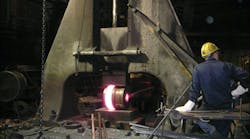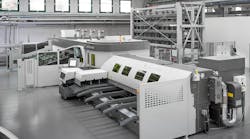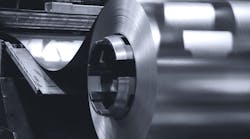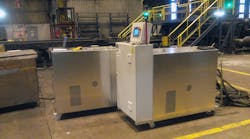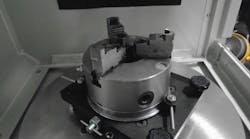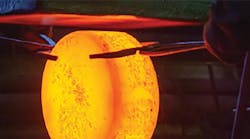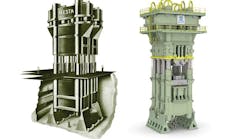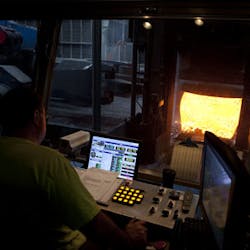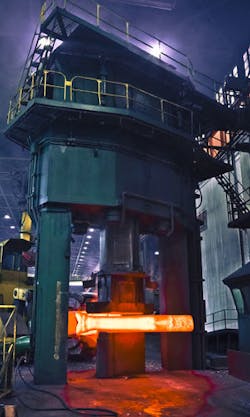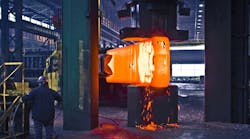In 2013, the Forging Industry Association (FIA) celebrates 100 years of activity and service. Through the past century of FIA’s and its predecessor groups’ activities, the forging industry has undergone remarkable change. Its core activity continues to be summarized best as “heat it and beat it,” but forging today has evolved into a sophisticated process, guided by computer modeling, monitored by PLCs, processing exotic materials, and deploying state-of-the-art methods in the development of net-shape finished products. How did we get here?
In the previous installment, “Early Innovations Drove Forging Forward” (January/February 2013), we scoured the FIA archives to highlight numerous technology innovations prior to World War II that shape the modern forge shop. We pick up the story at that point to chronicle the forging industry’s technological advances.
World War II drove technological innovation worldwide, and across its disciplines and industries. Forging certainly was no exception. Consider induction heating, a concept that found industrial uses as early as the 1920s. But, for forgers, World War II brought the process forward as a means of surface and case hardening, which made materials more durable for munitions, armor, and transport applications.
After the War, demand for aircraft and automobiles also propelled the use of induction, and advances in power-generation technology allowed the heating process to gain in reliability and efficiency.
Bigger presses, advanced materials
The second “war to end all wars” also hastened the evolution of presses. With metallurgists creating new alloys with unique properties, existing presses and hammers could not always muster the force to form them adequately. The U.S. Air Force Heavy Press Program, by which the U.S. government spearheaded an effort to continue German forgers’ developments, to maintain a lead on the Soviet Union in production and use of heavy forging presses, provides a capsule of the Cold War Era in the North American forging industry.
Two closed-die presses — a 50,000-ton hydraulic press operated by Alcoa in Cleveland, and another 50,000-ton hydraulic machine operated by Wyman-Gordon in Grafton, MA — entered into production in 1955. Both presses resulted from technologies developed during World War II and were built for service during the Cold War that followed.
Just prior to the close of the War, the U.S. embarked on a program to counter large-forging-press operations undertaken in Germany. Allied intelligence teams, having examined downed German aircraft, identified large, complex structural elements and surmised that Germany had developed large forging and extrusion presses with capabilities well beyond the Allies’ technologies. A heavy-press program, if successful, could improve U.S. production of heavy complex parts, and that would improve in Allied aircraft designs.
After the War, the Allies seized large forging and extrusion presses in Germany, confirming the earlier intelligence. However, the largest of these, a 30,000-ton forging press, was commandeered by the Soviets, which gave the U.S. new incentive to design and build its own large-scale forging machinery.
The Heavy Press Program got underway in 1950. Top-level government and industry planners believed that heavy presses would be vital to the Cold War defense effort by establishing a capability to produce large structural parts for advanced aircraft and other systems, with a high strength-to-weight ratios, at unparalleled rates, and at low cost.
Air Force Plant 47 was authorized for construction in Cleveland in 1952, adjacent to the Aluminum Co. of America (Alcoa) plant. The 50,000-ton, Mesta-built press, dubbed the ‘Super Giant,’ is the larger of two heavy presses installed there. Alcoa was the prime operating contractor for Air Force Plant 47 once it began operation on May 5, 1955. In 1982, Alcoa purchased the operation outright.
In 2012, after a three-year, $100-million rebuild, the massive press returned to service at Alcoa. The extensive rehabilitation included a new control system that makes it possible to produce more precise finished pieces that require less machining.
At Wyman-Gordon in Grafton, MA, the 35,000- and 50,000-ton machines installed as part of the Heavy Press Program were designed and built by Loewy Construction Co. The 35,000-ton heavy press entered service in February 1955, with the 50,000-ton press (aka ‘The 50’) coming online in October of that year. At the time it was the largest machine ever built.
Foundations for The 50 descend 100 feet into bedrock — believed to be the deepest excavation ever made in the United States for a machine. As noted in a history of the press prepared by the American Society of Mechanical Engineers (ASME), only one operator was responsible for controlling The 50. With 106 million pounds of pressure at his command, that operator was sometimes referred to as “the most powerful person in the world.”
In 1982, Wyman-Gordon purchased the Grafton plant and its presses from the U.S. government, and both The 50 and Super Giant remain in service.
In 1981, ASME designated Alcoa’s 50,000-ton press as a National Historic Engineering Landmark, and in 1983 it awarded the same designation to Wyman-Gordon’s ‘50.’ Their ability to generate force still staggers the imagination. Consider that 50,000 tons is equivalent to the pressure exerted by the weight of a steel ingot 612 ft. high, placed on end to cover an entire 26 × 12-ft. die bed.
In 1951, Lt. Gen. K. B. Wolfe, the Air Force’s champion of the Heavy Press Program, saw these monster machines as game changers. “The Heavy Press Program will revolutionize plane making,” he predicted. It did, and the machines it sponsored are doing so even now.
Research yields a better process
With forging technology becoming so important to addressing Cold War tensions; and as the post-war economic expansion propelled demand in construction, mining, and transportation, the Drop Forging Association (predecessor to FIA) recognized the need to promote the industry to students. The industry’s leaders also were keen to address some perceived shortcomings in forging technology research. While large steelmakers maintained material-research facilities, similar resources for forging technology were lacking at universities and in federal programs.
As a result, according to some sources, traditionally forged products like crankshafts and connecting rods were being cast, or produced via powder metallurgy — two processes that exhibited improvement in material and structural properties. To combat market-share losses, in 1961 the Forging Industry Educational and Research Foundation was formed
In the 1960s, the Space Race and other advances in the aerospace market spurred further forging-industry progress. Forgers large and small supplied critical components for space vehicles and aircraft. Increased use of titanium and other exotic materials necessitated larger, more sophisticated forming machinery and increased attention to metallurgy. The association’s research arm helped forgers to develop methods for producing components using those new materials.
In the early 1980s, increasing foreign competition was challenging North American manufacturing, and presented some particular difficulties for domestic forging operations. One way to address that was to develop capabilities for producing near-net-shape close-tolerance forgings — an R&D effort that continues to this day.
A panel of impression-die-forging experts assembled by FIA in 1983 explored issues of competitiveness and close-tolerance forging as a competitive advantage.
“First, you’ve got to consider the evolution of the different forging processes,” explained one panelist. “One that has been mentioned here is isothermal forging. But, even within the scope of the basic forging tool — the hammer — we have had an evolution of tolerance and geometric capabilities, just because we have a better understanding of lubrication, metallurgy and other factors affecting the forging process.
“Also, we better understand and are spending more time with tool design,” he continued. “We are applying today’s technology to bear on it — much more than we were able to 10 years ago. This has led to closer-tolerance geometrics.
“And, while we do not have an active CAD/CAM design at the moment, we are headed that way. It can be done. We can simulate plastic deformation with the aid of computers. The future is in this, whether you’re dealing with a hammer, press, isothermal or whatever.”
Prescient words indeed: even now close-tolerance advances and the evolution of CAD/CAM and simulation technologies, along with process-control improvements, guide forging’s technical progress.
By the 1970s, PLC controls and rudimentary CAD systems began appearing on the forging landscape, as did automated material-handling systems. The ability to control force and timing with precision, while carefully manipulating material, improved repeatability with every downstroke and hit. Advances in computing power, combined with research and testing to produce accurate simulation models, have enabled design of parts and tooling that function precisely as designed from the start.
Forging tooling has benefitted by development of tough inserts for wear-prone areas, and the introduction of materials that increase temperature resistance. Machining advances, too, have shortened tool build time while improving product precision and increasing tool life. In addition, the same innovations that have improved tooling have allowed for construction of more robust and dependable forging equipment.
The progress summarized here only hints at the myriad technological advances that have shaped the forging operations over the past century. The idea is still the same: heat it and beat it. But, how and how well we heat it and beat it has undergone a transformation. Combining technology with skilled personnel keeps the forging industry strong, and promises a bright future.
Lou Kren is a freelance writer and former editor of FORGING. Contact him at [email protected]
